Photodynamic Therapy Using a Rose-Bengal Photosensitizer for Hepatocellular Carcinoma Treatment: Proposition for a Novel Green LED-Based Device for In Vitro Investigation
Abstract
1. Introduction
2. Materials and Methods
2.1. Device Description
2.1.1. Structure of CELL-LED-550/3
2.1.2. Choosing Underneath Illumination
2.2. Optical Characterization of CELL-LED-550/3
2.2.1. Determination of the Spectral Irradiance Reaching the Bottom Exterior Surface of the Wells
- is the irradiance measured, at the position considered, using a dedicated detector whose wavelength is set at and () should be chosen close to the central wavelength of the illumination device,
- is the spectral relative sensitivity of the dedicated detector at wavelength ,
- is the normalized spectral irradiance of the illumination device.
2.2.2. Overlapping of the Spectral Irradiance with the Absorption Spectrum of Rose Bengal
2.2.3. Stability over Time of the Spectral Irradiance
2.2.4. Determination of the Impact of the Bottom Thickness of a Greiner 96-Well Plate on the Total Irradiance
2.3. Thermal Characterization of CELL-LED-550/3
2.4. Biologic Experiments
2.4.1. Cell Culture and Photosensitizer
2.4.2. In Vitro Photodynamic Therapy Protocol
2.4.3. Cell Viability Assays
2.4.4. Microscopic Observation
2.4.5. Statistical Analysis
3. Results
3.1. Optical Characterization of CELL-LED-550/3
3.1.1. Determination of the Spectral Irradiance Reaching the Bottom Exterior Surface of the Wells
3.1.2. Overlapping of the Spectral Irradiance with the Absorption Spectrum of Rose Bengal
3.1.3. Stability over Time of the Spectral Irradiance
3.1.4. Determination of the Impact of the Bottom Thickness of a Greiner 96-Well Plate on the Total Irradiance
3.2. Thermal Characterization of CELL-LED-550/3
3.3. In Vitro Cytotoxic PDT Study Using CELL-LED-550
3.3.1. Light Dose Modulation
3.3.2. RB Concentration Modulation with Light Modulation
4. Discussion
5. Conclusions
Author Contributions
Funding
Institutional Review Board Statement
Informed Consent Statement
Data Availability Statement
Conflicts of Interest
References
- Ferlay, J.; Soerjomataram, I.; Dikshit, R.; Eser, S.; Mathers, C.; Rebelo, M.; Parkin, D.M.; Forman, D.; Bray, F. Cancer Incidence and Mortality Worldwide: Sources, Methods and Major Patterns in GLOBOCAN 2012. Int. J. Cancer 2015, 136, E359–E386. [Google Scholar] [CrossRef] [PubMed]
- Jemal, A.; Ward, E.M.; Johnson, C.J.; Cronin, K.A.; Ma, J.; Ryerson, B.; Mariotto, A.; Lake, A.J.; Wilson, R.; Sherman, R.L.; et al. Annual Report to the Nation on the Status of Cancer, 1975–2014, Featuring Survival. J. Natl. Cancer Inst. 2017, 109, djx030. [Google Scholar] [CrossRef] [PubMed]
- Ioannou, G.N.; Splan, M.F.; Weiss, N.S.; McDonald, G.B.; Beretta, L.; Lee, S.P. Incidence and Predictors of Hepatocellular Carcinoma in Patients with Cirrhosis. Clin. Gastroenterol. Hepatol. 2007, 5, 938–945.e4. [Google Scholar] [CrossRef]
- Addissouky, T.A.; Sayed, I.E.T.E.; Ali, M.M.A.; Wang, Y.; Baz, A.E.; Khalil, A.A.; Elarabany, N. Latest Advances in Hepatocellular Carcinoma Management and Prevention through Advanced Technologies. Egypt. Liver J. 2024, 14, 2. [Google Scholar] [CrossRef]
- Gong, X.-Q.; Liu, N.; Tao, Y.-Y.; Li, L.; Li, Z.-M.; Yang, L.; Zhang, X.-M. Radiomics Models Based on Multisequence MRI for Predicting PD-1/PD-L1 Expression in Hepatocellular Carcinoma. Sci. Rep. 2023, 13, 7710. [Google Scholar] [CrossRef]
- Yan, E.; Kwek, G.; Qing, N.S.; Lingesh, S.; Xing, B. Antimicrobial Photodynamic Therapy for the Remote Eradication of Bacteria. Chempluschem 2023, 88, e202300009. [Google Scholar] [CrossRef]
- Bakirtzi, K.; Papadimitriou, I.; Vakirlis, E.; Lallas, A.; Sotiriou, E. Photodynamic Therapy for Field Cancerization in the Skin: Where Do We Stand? Dermatol. Pract. Concept. 2023, 13, e2023291. [Google Scholar] [CrossRef]
- Dong, Q.; Kang, Y.; Zhang, R. Treatment of Superficial Mycoses Using Photodynamic Therapy: A Systematic Review and Meta-Analysis. Photobiomodul. Photomed. Laser Surg. 2023, 41, 37–47. [Google Scholar] [CrossRef]
- Ren, F.; Zhao, S.; Yang, C.; Liu, J.; Shang, Q.; Feng, K.; Kang, X.; Zhang, R.; Wang, X.; Wang, X. Applications of Photodynamic Therapy in Extramammary Paget’s Disease. Am. J. Cancer Res. 2023, 13, 4492–4507. [Google Scholar]
- Mazur, E.; Kwiatkowska, D.; Reich, A. Photodynamic Therapy in Pigmented Basal Cell Carcinoma-A Review. Biomedicines 2023, 11, 3099. [Google Scholar] [CrossRef]
- Chen, M.; Zhou, A.; Khachemoune, A. Photodynamic Therapy in Treating a Subset of Basal Cell Carcinoma: Strengths, Shortcomings, Comparisons with Surgical Modalities, and Potential Role as Adjunctive Therapy. Am. J. Clin. Dermatol. 2023, 25, 99–118. [Google Scholar] [CrossRef] [PubMed]
- Kwiatkowski, S.; Knap, B.; Przystupski, D.; Saczko, J.; Kędzierska, E.; Knap-Czop, K.; Kotlińska, J.; Michel, O.; Kotowski, K.; Kulbacka, J. Photodynamic Therapy—Mechanisms, Photosensitizers and Combinations. Biomed. Pharmacother. 2018, 106, 1098–1107. [Google Scholar] [CrossRef] [PubMed]
- Agostinis, P.; Berg, K.; Cengel, K.A.; Foster, T.H.; Girotti, A.W.; Gollnick, S.O.; Hahn, S.M.; Hamblin, M.R.; Juzeniene, A.; Kessel, D.; et al. Photodynamic Therapy of Cancer: An Update. CA Cancer J. Clin. 2011, 61, 250–281. [Google Scholar] [CrossRef] [PubMed]
- Falk-Mahapatra, R.; Gollnick, S.O. Photodynamic Therapy and Immunity: An Update. Photochem. Photobiol. 2020, 96, 550–559. [Google Scholar] [CrossRef]
- Norn, M.S. Rose Bengal Vital Staining. Staining of Cornea and Conjunctiva by 10% Rose Bengal, Compared with 1%. Acta Ophthalmol. 1970, 48, 546–559. [Google Scholar] [CrossRef]
- Demartis, S.; Obinu, A.; Gavini, E.; Giunchedi, P.; Rassu, G. Nanotechnology-Based Rose Bengal: A Broad-Spectrum Biomedical Tool. Dyes Pigments 2021, 188, 109236. [Google Scholar] [CrossRef]
- Wachter, E.A.; Dees, C.; Harkins, J.; Fisher, W.G.; Scott, T. Functional Imaging of Photosensitizers Using Multiphoton Microscopy. In Proceedings of the Multiphoton Microscopy in the Biomedical Sciences II, San Jose, CA, USA, 17 June 2002; SPIE: Bellingham, WA, USA, 2002; Volume 4620, pp. 143–147. [Google Scholar]
- Koevary, S.B. Selective Toxicity of Rose Bengal to Ovarian Cancer Cells In Vitro. Int. J. Physiol. Pathophysiol. Pharmacol. 2012, 4, 99–107. [Google Scholar]
- Thompson, J.F.; Hersey, P.; Wachter, E. Chemoablation of Metastatic Melanoma Using Intralesional Rose Bengal. Melanoma Res. 2008, 18, 405–411. [Google Scholar] [CrossRef]
- Zamani Taghizadeh Rabe, S.; Mousavi, S.H.; Tabasi, N.; Rastin, M.; Zamani Taghizadeh Rabe, S.; Siadat, Z.; Mahmoudi, M. Rose Bengal Suppresses Gastric Cancer Cell Proliferation via Apoptosis and Inhibits Nitric Oxide Formation in Macrophages. J. Immunotoxicol. 2014, 11, 367–375. [Google Scholar] [CrossRef]
- Toomey, P.; Kodumudi, K.; Weber, A.; Kuhn, L.; Moore, E.; Sarnaik, A.A.; Pilon-Thomas, S. Intralesional Injection of Rose Bengal Induces a Systemic Tumor-Specific Immune Response in Murine Models of Melanoma and Breast Cancer. PLoS ONE 2013, 8, e68561. [Google Scholar] [CrossRef]
- Liu, H.; Innamarato, P.P.; Kodumudi, K.; Weber, A.; Nemoto, S.; Robinson, J.L.; Crago, G.; McCardle, T.; Royster, E.; Sarnaik, A.A.; et al. Intralesional Rose Bengal in Melanoma Elicits Tumor Immunity via Activation of Dendritic Cells by the Release of High Mobility Group Box 1. Oncotarget 2016, 7, 37893–37905. [Google Scholar] [CrossRef] [PubMed]
- Thompson, J.F.; Agarwala, S.S.; Smithers, B.M.; Ross, M.I.; Scoggins, C.R.; Coventry, B.J.; Neuhaus, S.J.; Minor, D.R.; Singer, J.M.; Wachter, E.A. Phase 2 Study of Intralesional PV-10 in Refractory Metastatic Melanoma. Ann. Surg. Oncol. 2015, 22, 2135–2142. [Google Scholar] [CrossRef] [PubMed]
- Bartusik-Aebisher, D.; Ożóg, Ł.; Domka, W.; Aebisher, D. Rose Bengal and Future Directions in Larynx Tumor Photodynamic Therapy. Photochem. Photobiol. 2021, 97, 1445–1452. [Google Scholar] [CrossRef]
- Uppal, A.; Jain, B.; Gupta, P.K.; Das, K. Photodynamic Action of Rose Bengal Silica Nanoparticle Complex on Breast and Oral Cancer Cell Lines. Photochem. Photobiol. 2011, 87, 1146–1151. [Google Scholar] [CrossRef]
- Srivastav, A.K.; Mujtaba, S.F.; Dwivedi, A.; Amar, S.K.; Goyal, S.; Verma, A.; Kushwaha, H.N.; Chaturvedi, R.K.; Ray, R.S. Photosensitized Rose Bengal-Induced Phototoxicity on Human Melanoma Cell Line under Natural Sunlight Exposure. J. Photochem. Photobiol. B 2016, 156, 87–99. [Google Scholar] [CrossRef]
- Panzarini, E.; Inguscio, V.; Fimia, G.M.; Dini, L. Rose Bengal Acetate Photodynamic Therapy (RBAc-PDT) Induces Exposure and Release of Damage-Associated Molecular Patterns (DAMPs) in Human HeLa Cells. PLoS ONE 2014, 9, e105778. [Google Scholar] [CrossRef] [PubMed]
- Zhang, L.; Du, J.; Song, Q.; Zhang, C.; Wu, X. A Novel In Situ Dendritic Cell Vaccine Triggered by Rose Bengal Enhances Adaptive Antitumour Immunity. J. Immunol. Res. 2022, 2022, 1178874. [Google Scholar] [CrossRef]
- Kim, M.M.; Darafsheh, A. Light Sources and Dosimetry Techniques for Photodynamic Therapy. Photochem. Photobiol. 2020, 96, 280–294. [Google Scholar] [CrossRef]
- Thécua, E.; Ziane, L.; Grolez, G.P.; Fagart, A.; Kumar, A.; Leroux, B.; Baert, G.; Deleporte, P.; Vermandel, M.; Vignion-Dewalle, A.-S.; et al. A Warp-Knitted Light-Emitting Fabric-Based Device for In Vitro Photodynamic Therapy: Description, Characterization, and Application on Human Cancer Cell Lines. Cancers 2021, 13, 4109. [Google Scholar] [CrossRef]
- Hopkins, S.L.; Siewert, B.; Askes, S.H.C.; Veldhuizen, P.; Zwier, R.; Heger, M.; Bonnet, S. An in Vitro Cell Irradiation Protocol for Testing Photopharmaceuticals and the Effect of Blue, Green, and Red Light on Human Cancer Cell Lines. Photochem. Photobiol. Sci. 2016, 15, 644–653. [Google Scholar] [CrossRef]
- Zhang, K.; Timilsina, S.; Waguespack, M.; Kercher, E.M.; Spring, B.Q. An Open-Source LED Array Illumination System for Automated Multiwell Plate Cell Culture Photodynamic Therapy Experiments. Sci. Rep. 2022, 12, 19341. [Google Scholar] [CrossRef] [PubMed]
- Repina, N.A.; McClave, T.; Johnson, H.J.; Bao, X.; Kane, R.S.; Schaffer, D.V. Engineered Illumination Devices for Optogenetic Control of Cellular Signaling Dynamics. Cell Rep. 2020, 31, 107737. [Google Scholar] [CrossRef] [PubMed]
- Bounds, A.D.; Bailey, R.D.; Adams, C.T.; Callaghan, D.C.; Girkin, J.M. LightBox: A Multiwell Plate Illumination System for Photoactive Molecule Characterization. J. Biophotonics 2021, 14, e202000481. [Google Scholar] [CrossRef]
- Gholam, P.; Bosselmann, I.; Enk, A.H.; Dick, J. Low Irradiance Compared with Conventional Photodynamic Therapy in the Treatment of Actinic Keratoses. Photodermatol. Photoimmunol. Photomed. 2019, 35, 110–115. [Google Scholar] [CrossRef]
- Acquah, C.; Pabis, Z.; Seth, S.K.; Levi, L.; Crespo-Hernández, C.E. Low-Cost, 3D Printed Irradiation System for in Vitro Photodynamic Therapy Experiments. Photochem. Photobiol. 2023, 100, 530–540. [Google Scholar] [CrossRef] [PubMed]
- LED BOX Data Sheet. Available online: https://loja.biolambda.com/led-box- (accessed on 9 September 2024).
- optoWELL. Opto Biolabs. Available online: https://optobiolabs.com/products/optowell/ (accessed on 9 September 2024).
- Liu, H.; Daly, L.; Rudd, G.; Khan, A.P.; Mallidi, S.; Liu, Y.; Cuckov, F.; Hasan, T.; Celli, J.P. Development and Evaluation of a Low-Cost, Portable, LED-Based Device for PDT Treatment of Early-Stage Oral Cancer in Resource-Limited Settings. Lasers Surg. Med. 2019, 51, 345–351. [Google Scholar] [CrossRef]
- Bansal, A.; Yang, F.; Xi, T.; Zhang, Y.; Ho, J.S. In Vivo Wireless Photonic Photodynamic Therapy. Proc. Natl. Acad. Sci. USA 2018, 115, 1469–1474. [Google Scholar] [CrossRef]
- Kirino, I.; Fujita, K.; Sakanoue, K.; Sugita, R.; Yamagishi, K.; Takeoka, S.; Fujie, T.; Uemoto, S.; Morimoto, Y. Metronomic Photodynamic Therapy Using an Implantable LED Device and Orally Administered 5-Aminolevulinic Acid. Sci. Rep. 2020, 10, 22017. [Google Scholar] [CrossRef]
- Vignion-Dewalle, A.-S.; Baert, G.; Thecua, E.; Lecomte, F.; Vicentini, C.; Abi-Rached, H.; Mortier, L.; Mordon, S. Comparison of 10 Efficient Protocols for Photodynamic Therapy of Actinic Keratosis: How Relevant Are Effective Light Dose and Local Damage in Predicting the Complete Response Rate at 3 Months? Lasers Surg. Med. 2018, 50, 576–589. [Google Scholar] [CrossRef]
- Vignion-Dewalle, A.-S.; Baert, G.; Thecua, E.; Vicentini, C.; Mortier, L.; Mordon, S. Photodynamic Therapy for Actinic Keratosis: Is the European Consensus Protocol for Daylight PDT Superior to Conventional Protocol for Aktilite CL 128 PDT? J. Photochem. Photobiol. B 2017, 174, 70–77. [Google Scholar] [CrossRef][Green Version]
- Chen, H.-J.; Zhou, X.-B.; Wang, A.-L.; Zheng, B.-Y.; Yeh, C.-K.; Huang, J.-D. Synthesis and Biological Characterization of Novel Rose Bengal Derivatives with Improved Amphiphilicity for Sono-Photodynamic Therapy. Eur. J. Med. Chem. 2018, 145, 86–95. [Google Scholar] [CrossRef] [PubMed]
- Yang, J.; Chen, A.C.-H.; Wu, Q.; Jiang, S.; Liu, X.; Xiong, L.; Xia, Y. The Influence of Temperature on 5-Aminolevulinic Acid-Based Photodynamic Reaction in Keratinocytes in Vitro. Photodermatol. Photoimmunol. Photomed. 2010, 26, 83–88. [Google Scholar] [CrossRef] [PubMed]
- Novak, B.; Heesen, L.; Schary, N.; Lübbert, H. The Influence of Different Illumination Parameters on Protoporphyrin IX Induced Cell Death in Squamous Cell Carcinoma Cells. Photodiagn. Photodyn. Ther. 2018, 21, 385–392. [Google Scholar] [CrossRef]
- Middelburg, T.A.; Van Zaane, F.; De Bruijn, H.S.; Van Der Ploeg-van den Heuvel, A.; Sterenborg, H.J.C.M.; Neumann, H.A.M.; De Haas, E.R.M.; Robinson, D.J. Fractionated Illumination at Low Fluence Rate Photodynamic Therapy in Mice. Photochem. Photobiol. 2010, 86, 1140–1146. [Google Scholar] [CrossRef] [PubMed]
- Seshadri, M.; Bellnier, D.A.; Vaughan, L.A.; Spernyak, J.A.; Mazurchuk, R.; Foster, T.H.; Henderson, B.W. Light Delivery over Extended Time Periods Enhances the Effectiveness of Photodynamic Therapy. Clin. Cancer Res. 2008, 14, 2796–2805. [Google Scholar] [CrossRef]
- Mordon, S.; Vignion-Dewalle, A.S.; Abi-Rached, H.; Thecua, E.; Lecomte, F.; Vicentini, C.; Deleporte, P.; Béhal, H.; Kerob, D.; Hommel, T.; et al. The Conventional Protocol vs. a Protocol Including Illumination with a Fabric-Based Biophotonic Device (the Phosistos Protocol) in Photodynamic Therapy for Actinic Keratosis: A Randomized, Controlled, Noninferiority Clinical Study. Br. J. Dermatol. 2020, 182, 76–84. [Google Scholar] [CrossRef]
- Vicentini, C.; Vignion-Dewalle, A.S.; Thecua, E.; Lecomte, F.; Maire, C.; Deleporte, P.; Béhal, H.; Kerob, D.; Duhamel, A.; Mordon, S.; et al. Photodynamic Therapy for Actinic Keratosis of the Forehead and Scalp: A Randomized, Controlled, Phase II Clinical Study Evaluating the Noninferiority of a New Protocol Involving Irradiation with a Light-Emitting, Fabric-Based Device (the Flexitheralight Protocol) Compared with the Conventional Protocol Involving Irradiation with the Aktilite CL 128 Lamp. Br. J. Dermatol. 2019, 180, 765–773. [Google Scholar] [CrossRef]
- Henderson, B.W.; Busch, T.M.; Snyder, J.W. Fluence Rate as a Modulator of PDT Mechanisms. Lasers Surg. Med. 2006, 38, 489–493. [Google Scholar] [CrossRef]
- Scholz, M.; Petusseau, A.F.; Gunn, J.R.; Shane Chapman, M.; Pogue, B.W. Imaging of Hypoxia, Oxygen Consumption and Recovery in Vivo during ALA-Photodynamic Therapy Using Delayed Fluorescence of Protoporphyrin IX. Photodiagn. Photodyn. Ther. 2020, 30, 101790. [Google Scholar] [CrossRef]
- Panzarini, E.; Inguscio, V.; Dini, L. Overview of Cell Death Mechanisms Induced by Rose Bengal Acetate-Photodynamic Therapy. Int. J. Photoenergy 2011, 2011, e713726. [Google Scholar] [CrossRef]
- Dhillon, S.K.; Porter, S.L.; Rizk, N.; Sheng, Y.; McKaig, T.; Burnett, K.; White, B.; Nesbitt, H.; Matin, R.N.; McHale, A.P.; et al. Rose Bengal-Amphiphilic Peptide Conjugate for Enhanced Photodynamic Therapy of Malignant Melanoma. J. Med. Chem. 2020, 63, 1328–1336. [Google Scholar] [CrossRef]
- Provectus Biopharmaceuticals, Inc. A Phase 1 Study to Assess the Safety, Tolerability and Pharmacokinetics of PV-10 Chemoablation of Cancer Metastatic to the Liver or Hepatocellular Carcinoma Not Amenable to Resection or Transplant; Provectus Biopharmaceuticals, Inc.: Knoxville, TN, USA, 2022. Available online: https://clinicaltrials.gov/study/NCT00986661 (accessed on 9 September 2024).
- Patel, S.; Carter, B.W.; Balmes, G.; Rider, H.; Joseph, J.; Zobniw, C.; Trinh, V.; Anderson, J.; Sheth, R.; Murthy, R.; et al. A Phase I Study of Percutaneous Oncolytic Rose Bengal Disodium for Metastatic Uveal Melanoma Patients with Hepatic Metastases: A Single-Center Cohort Summary. Ann. Oncol. 2019, 30, xi45. [Google Scholar] [CrossRef]
- Price, T.J.; Cehic, G.; Wachter, E.; Sebben, R.; Reid, J.; Alawawdeh, A.M.I.; McGregor, M.; Kirkwood, I.; Rodrigues, D.; Neuhaus, S.; et al. 1106P Phase I Study of Hepatic Intralesional Rose Bengal Disodium (PV10), an Autolytic Immunotherapy, in Metastatic Neuroendocrine Neoplasms. Ann. Oncol. 2021, 32, S913. [Google Scholar] [CrossRef]
- Zager, J.S.; Sarnaik, A.S.; Pilon-Thomas, S.; Beatty, M.; Han, D.; Lu, G.; Agarwala, S.S.; Ross, M.; Shirai, K.; Essner, R.; et al. 1123P A Phase Ib Study of Rose Bengal Disodium and Anti-PD-1 in Metastatic Cutaneous Melanoma: Initial Results in Patients Refractory to Checkpoint Blockade. Ann. Oncol. 2020, 31, S755–S756. [Google Scholar] [CrossRef]
- Price, T.J.; Cehic, G.; Kirkwood, I.; Maddern, G.; Wachter, E.A.; Sarson, D.; Sebben, R.; Leopardi, L.; Reid, J.; Neuhaus, S.J. A Phase I Study of Oncolytic Immunotherapy of Metastatic Neuroendocrine Tumours Using Intralesional Rose Bengal Disodium. Ann. Oncol. 2018, 29, viii478. [Google Scholar] [CrossRef]
- Carter, B.W.; Murthy, R.; Balmes, G.; Wachter, E.A.; Patel, S. Response Assessment of Metastatic Uveal Melanoma Treated with Rose Bengal Disodium. Ann. Oncol. 2019, 30, xi46. [Google Scholar] [CrossRef]
- Zhang, S.-Q.; Liu, K.-J.; Yao, H.-L.; Lei, S.-L.; Lei, Z.-D.; Yi, W.-J.; Xiong, L.; Zhao, H. Photodynamic Therapy as Salvage Therapy for Residual Microscopic Cancer after Ultra-Low Anterior Resection: A Case Report. World J. Clin. Cases 2019, 7, 798–804. [Google Scholar] [CrossRef] [PubMed]
- Yu, J.; Green, M.D.; Li, S.; Sun, Y.; Journey, S.N.; Choi, J.E.; Rizvi, S.M.; Qin, A.; Waninger, J.J.; Lang, X.; et al. Liver Metastasis Restrains Immunotherapy Efficacy via Macrophage-Mediated T Cell Elimination. Nat. Med. 2021, 27, 152–164. [Google Scholar] [CrossRef]
- Jiang, W.; Liang, M.; Lei, Q.; Li, G.; Wu, S. The Current Status of Photodynamic Therapy in Cancer Treatment. Cancers 2023, 15, 585. [Google Scholar] [CrossRef]
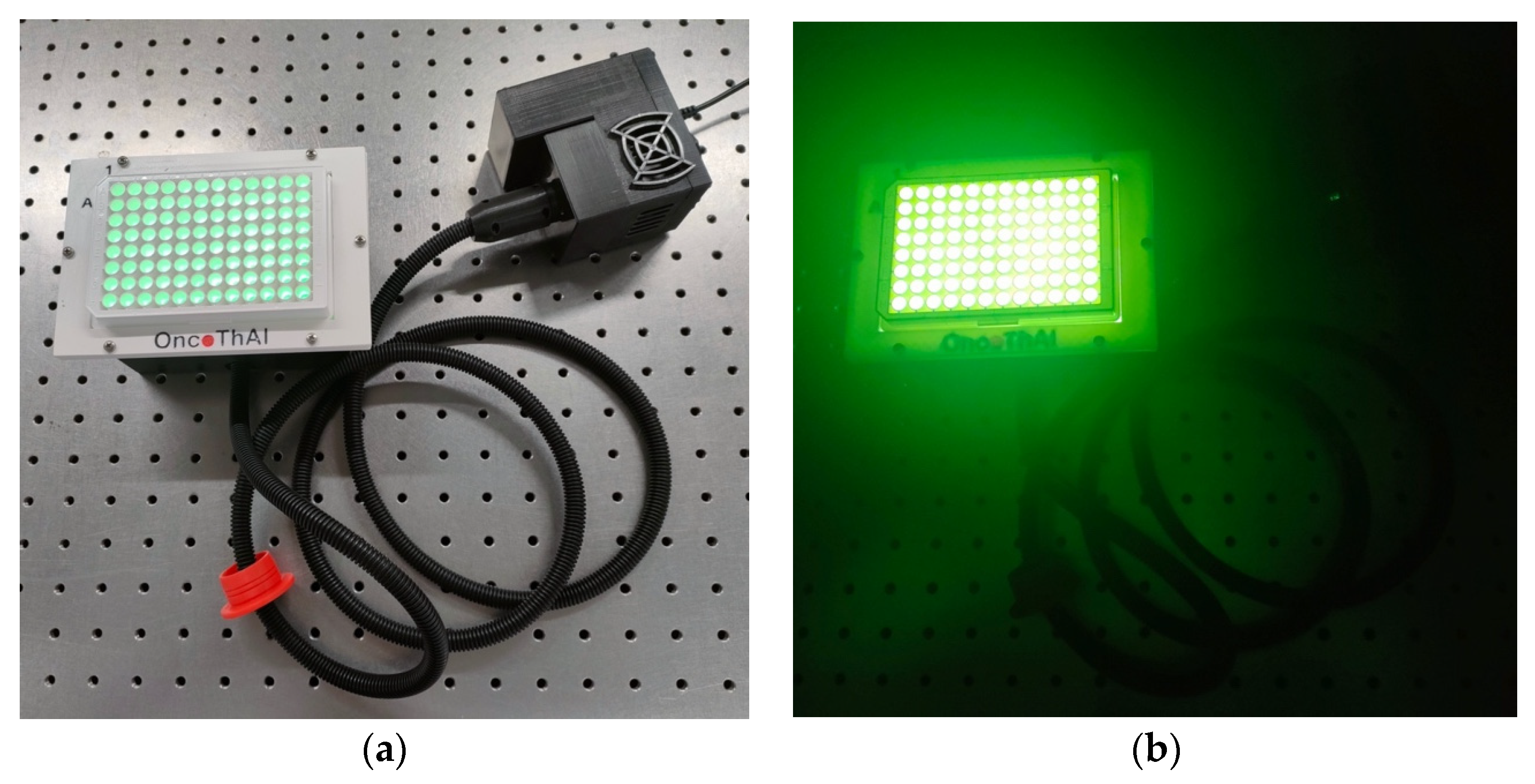
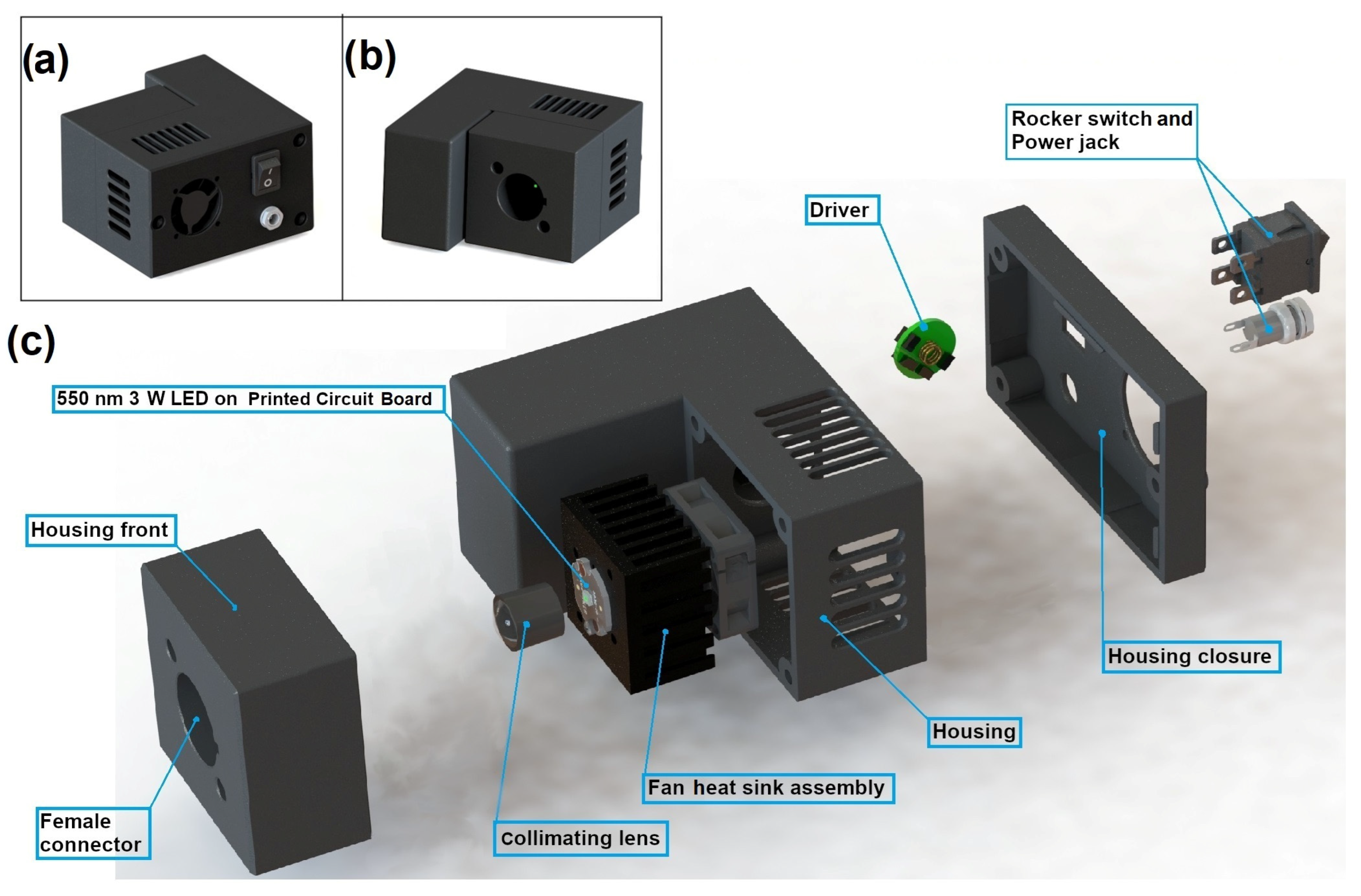
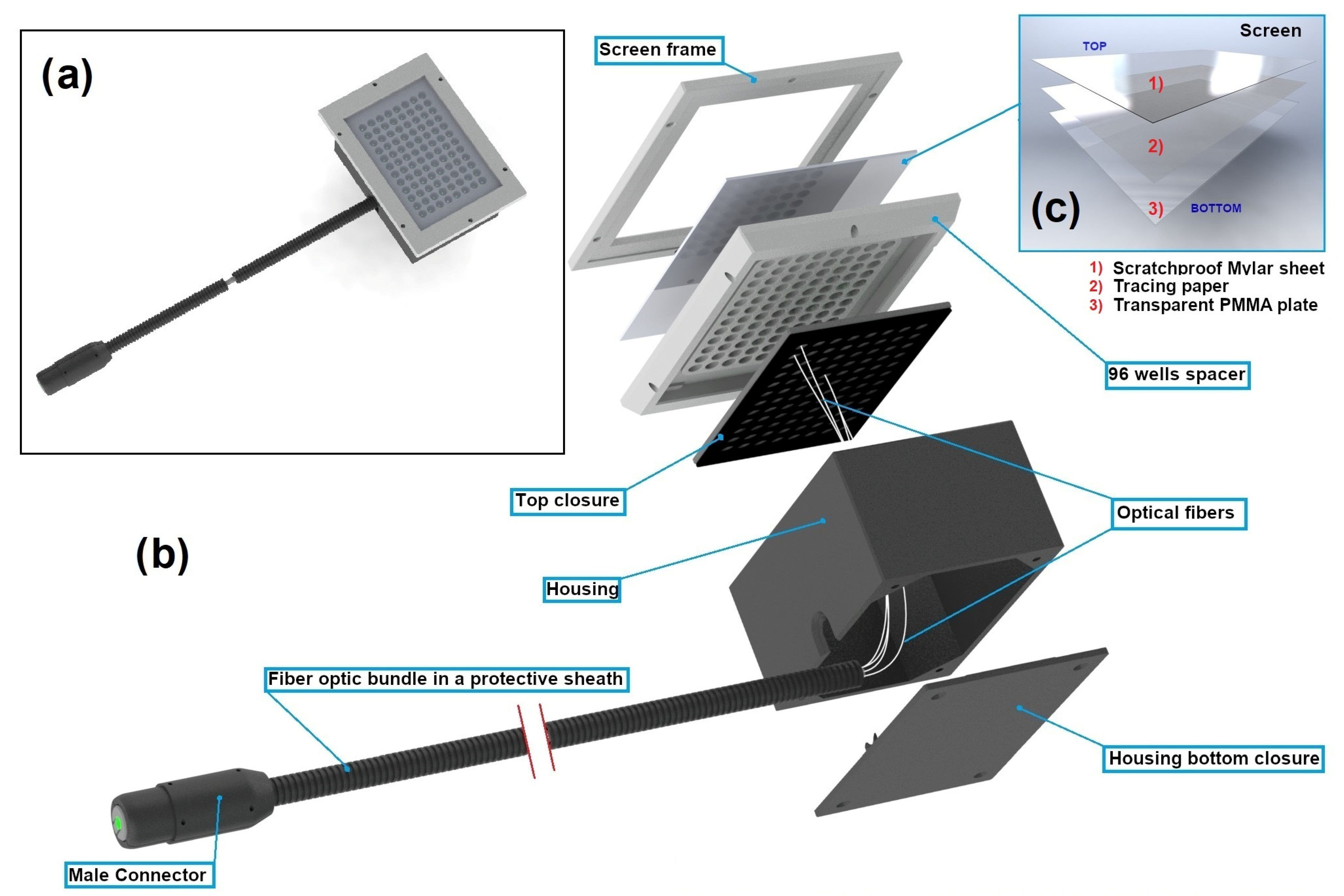
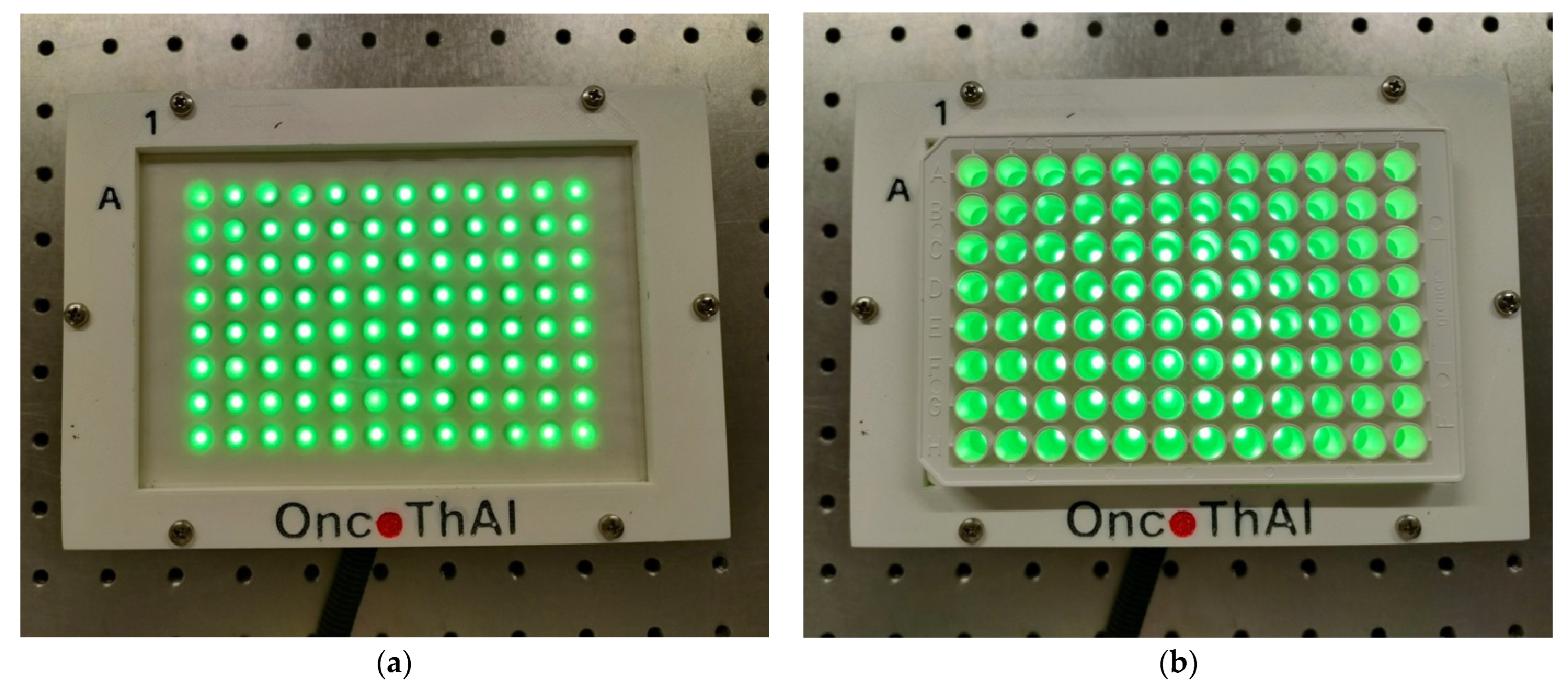
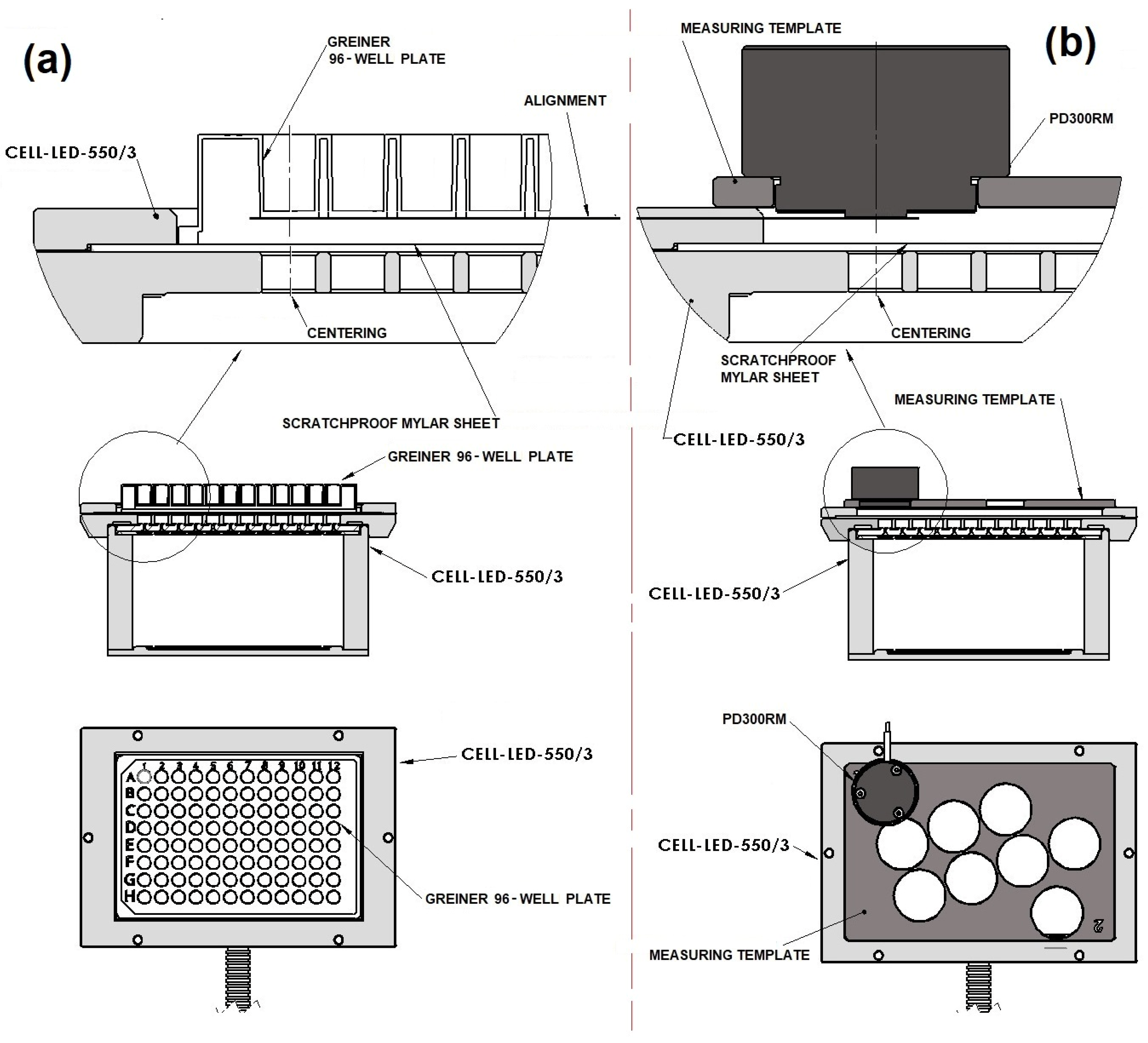


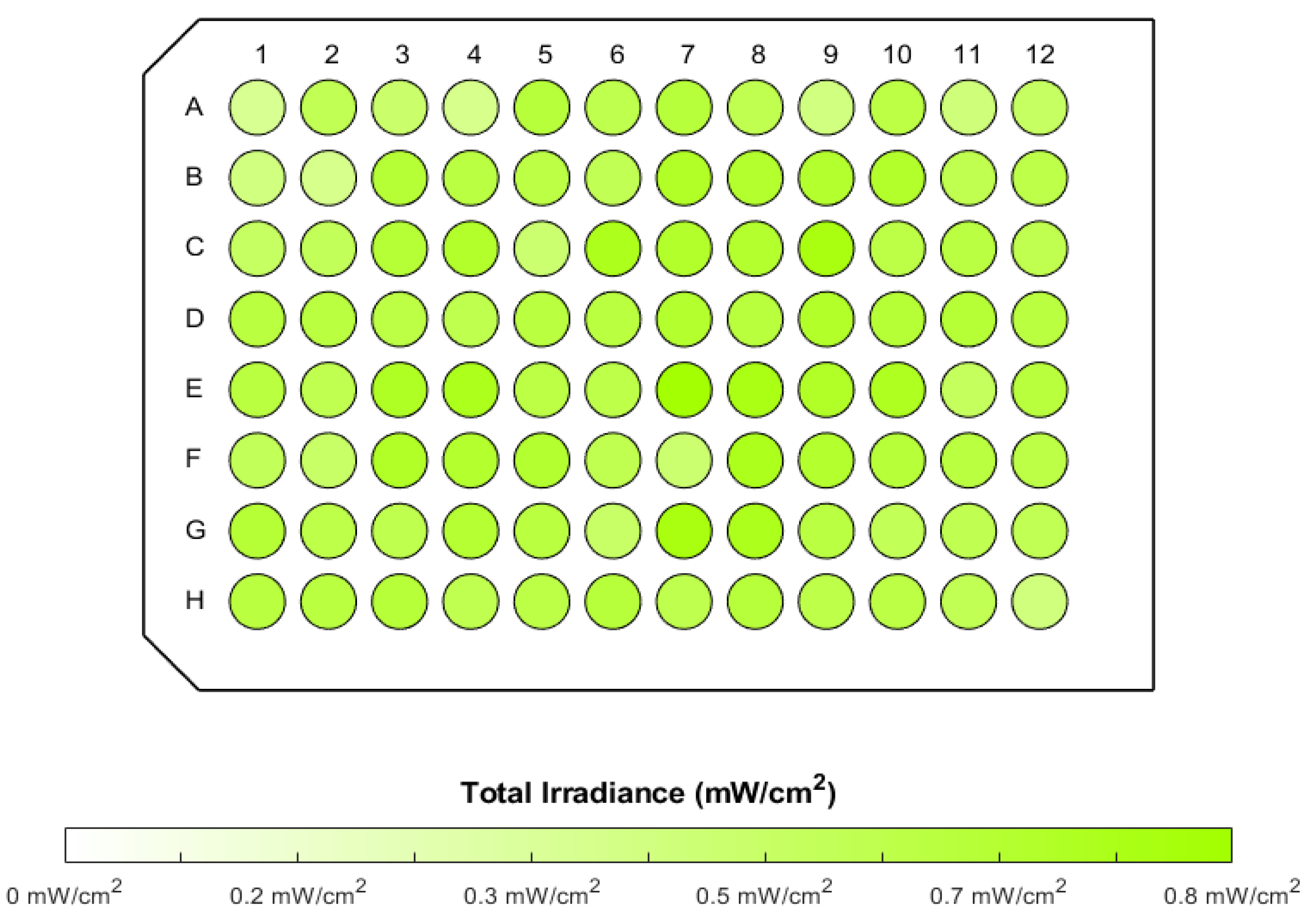

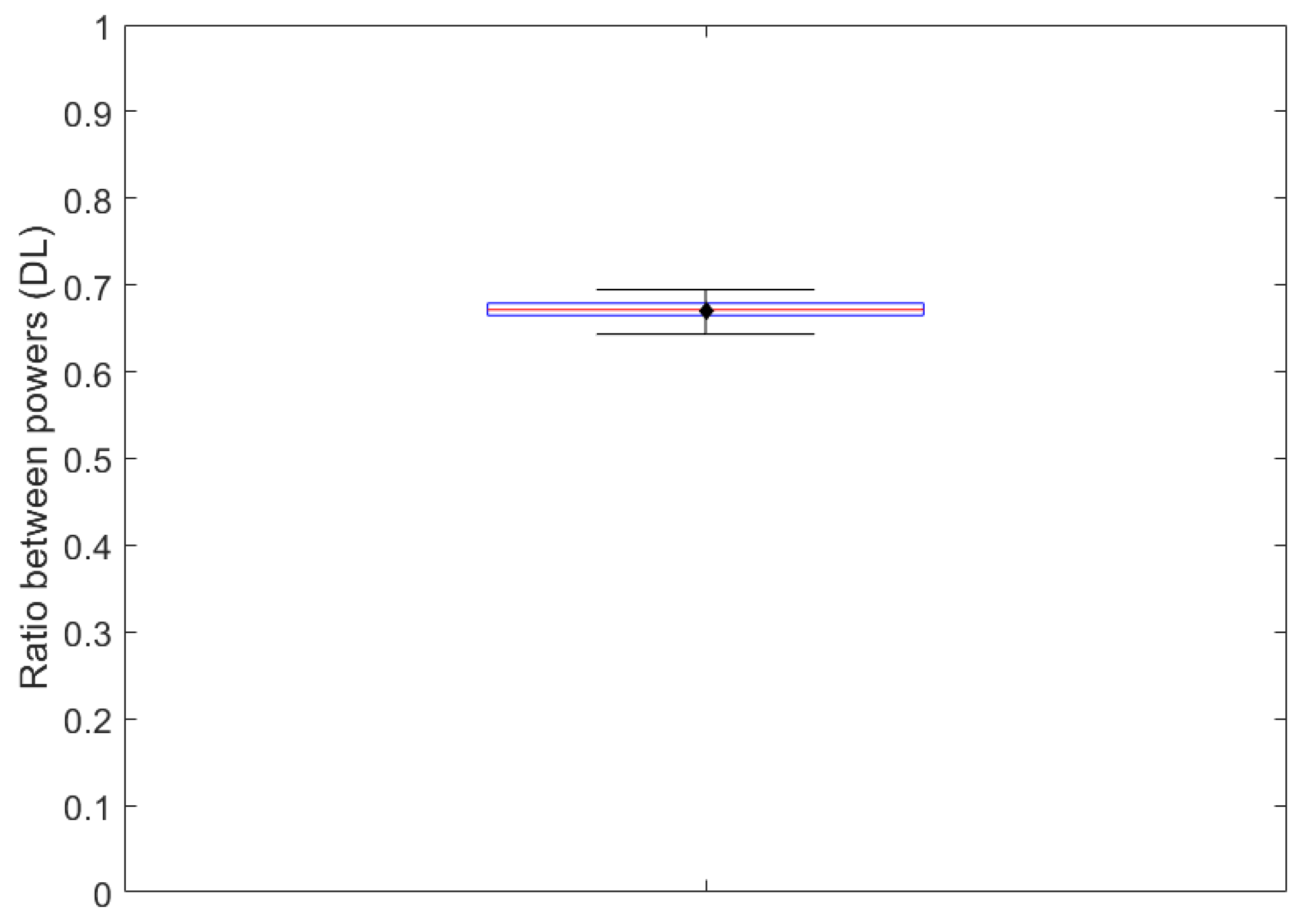
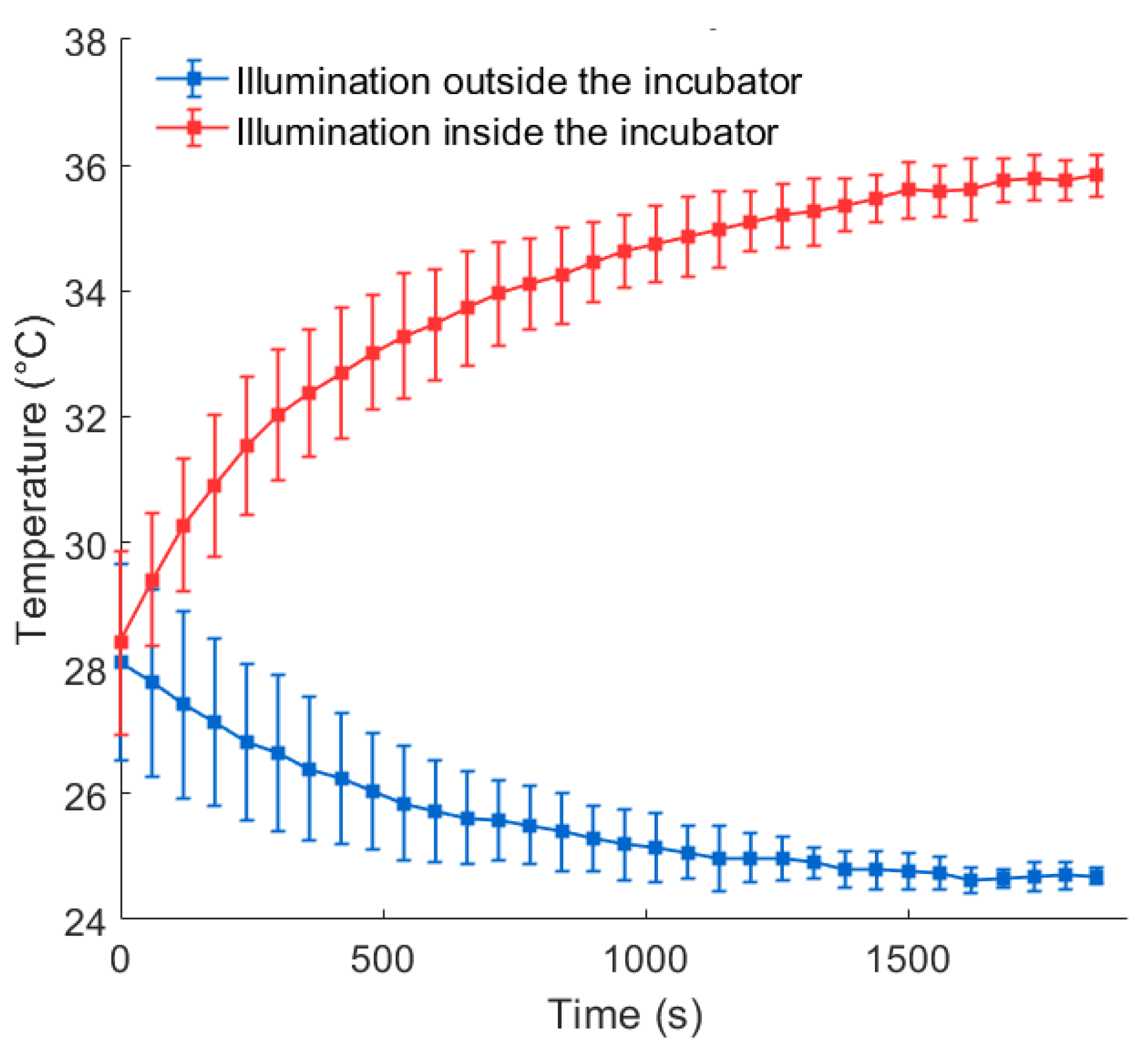
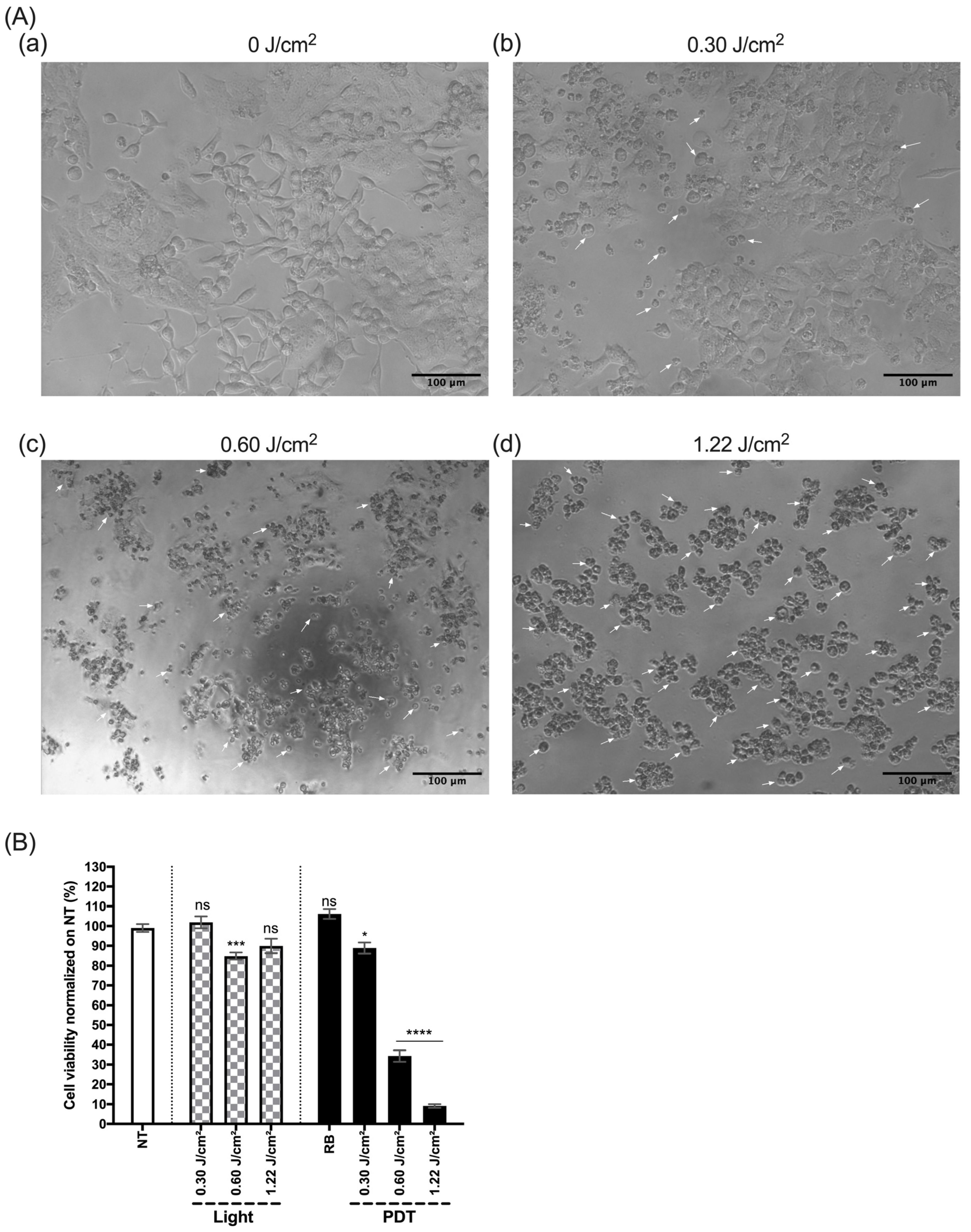
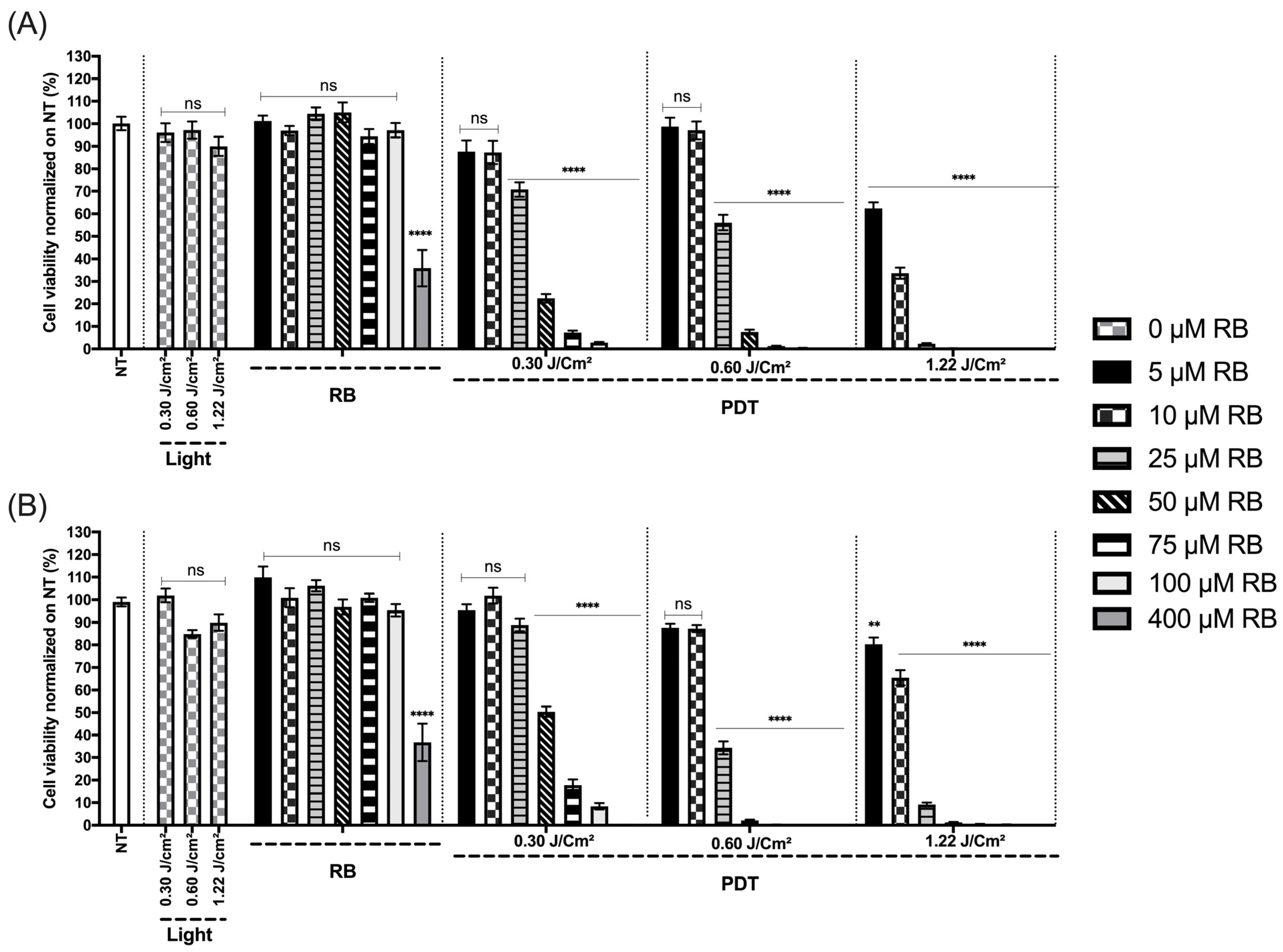
Disclaimer/Publisher’s Note: The statements, opinions and data contained in all publications are solely those of the individual author(s) and contributor(s) and not of MDPI and/or the editor(s). MDPI and/or the editor(s) disclaim responsibility for any injury to people or property resulting from any ideas, methods, instructions or products referred to in the content. |
© 2024 by the authors. Licensee MDPI, Basel, Switzerland. This article is an open access article distributed under the terms and conditions of the Creative Commons Attribution (CC BY) license (https://creativecommons.org/licenses/by/4.0/).
Share and Cite
Lefebvre, A.; Marhfor, S.; Baert, G.; Deleporte, P.; Grolez, G.P.; Boileau, M.; Morales, O.; Vignoud, S.; Delhem, N.; Mortier, L.; et al. Photodynamic Therapy Using a Rose-Bengal Photosensitizer for Hepatocellular Carcinoma Treatment: Proposition for a Novel Green LED-Based Device for In Vitro Investigation. Biomedicines 2024, 12, 2120. https://doi.org/10.3390/biomedicines12092120
Lefebvre A, Marhfor S, Baert G, Deleporte P, Grolez GP, Boileau M, Morales O, Vignoud S, Delhem N, Mortier L, et al. Photodynamic Therapy Using a Rose-Bengal Photosensitizer for Hepatocellular Carcinoma Treatment: Proposition for a Novel Green LED-Based Device for In Vitro Investigation. Biomedicines. 2024; 12(9):2120. https://doi.org/10.3390/biomedicines12092120
Chicago/Turabian StyleLefebvre, Anthony, Smail Marhfor, Gregory Baert, Pascal Deleporte, Guillaume Paul Grolez, Marie Boileau, Olivier Morales, Séverine Vignoud, Nadira Delhem, Laurent Mortier, and et al. 2024. "Photodynamic Therapy Using a Rose-Bengal Photosensitizer for Hepatocellular Carcinoma Treatment: Proposition for a Novel Green LED-Based Device for In Vitro Investigation" Biomedicines 12, no. 9: 2120. https://doi.org/10.3390/biomedicines12092120
APA StyleLefebvre, A., Marhfor, S., Baert, G., Deleporte, P., Grolez, G. P., Boileau, M., Morales, O., Vignoud, S., Delhem, N., Mortier, L., & Dewalle, A.-S. (2024). Photodynamic Therapy Using a Rose-Bengal Photosensitizer for Hepatocellular Carcinoma Treatment: Proposition for a Novel Green LED-Based Device for In Vitro Investigation. Biomedicines, 12(9), 2120. https://doi.org/10.3390/biomedicines12092120





